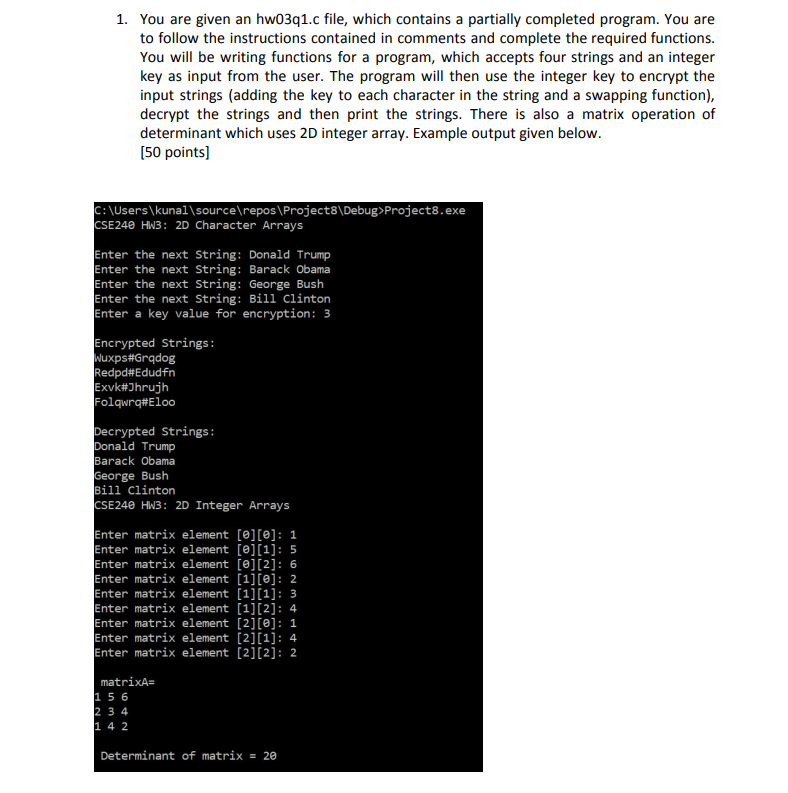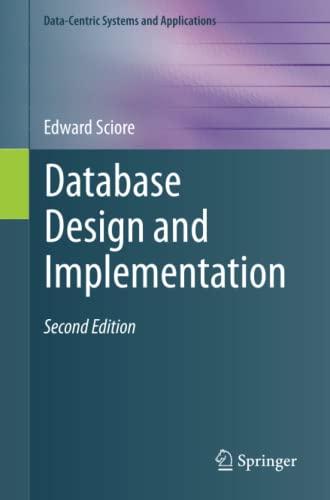Answered step by step
Verified Expert Solution
Question
1 Approved Answer
//CSE240 Fall 2018 HW3 // Enter your name here // State the IDE that you use: Visual Studio or GCC #include #include #pragma warning(disable :


//CSE240 Fall 2018 HW3 // Enter your name here // State the IDE that you use: Visual Studio or GCC #include#include #pragma warning(disable : 4996) // compiler directive for Visual Studio only // Read before you start: // You are given a partially complete program. Your job is to complete the functions in order for this program to work successfully. // All instructions are given above the required functions, please read them and follow them carefully. // You shoud not modify the function return types or parameters. // You can assume that all inputs are valid. Ex: If prompted for an integer, the user will input an integer. // Note: DO NOT use pointers in this assignment. Pointer assignment will be given in the next homework. // Global Macro Values. They are used to define the size of 2D array of characters #define NUM_STRINGS 4 #define STRING_LENGTH 35 // Forward Declarations void initializeStrings(char[NUM_STRINGS][STRING_LENGTH]); void swapFirstnameLastname(char strings[NUM_STRINGS][STRING_LENGTH]); void encryptStrings(char[NUM_STRINGS][STRING_LENGTH], int); void decryptStrings(char[NUM_STRINGS][STRING_LENGTH], int); void printStrings(char[NUM_STRINGS][STRING_LENGTH]); void inputMatrix(int matrixA[3][3]); void determinant(int matrixA[3][3]); // Problem 1: initializeStrings (5 points) // Traverse the 2D array of characters variable 'strings' (input from user in main() ) and set all characters in each // array to a null terminator so that there is a 4 row and 35 column 2D array full of null terminators. // The null terminator is represented by the character value '\0' and is used to denote the end of a string. // This may come in use later in the program to know the end of string. void initializeStrings(char strings[NUM_STRINGS][STRING_LENGTH]) { } // Problem 2: printStrings (5 points) // Traverse the 2D character array "strings" and print each of the contained strings. // See the example outputs provided in the word document. Your output should match the example outputs. void printStrings(char strings[NUM_STRINGS][STRING_LENGTH]) { } // Problem 3: swapFirstnameLastname (15 points) // Swap the first name and last name in each string of the 2D char array. // In main(), the user will input the string as the first name followed by a space and followed by the last name. For eg- "John Doe". The user will input 4 such strings in "strings[][]". // In this function, swap the first name and last name (with a space between them) in each string of the 2D char array For eg- "Doe John" // Hint: Use a temp[35] char array to hold a copy of the string, find the space in the temp[] to identify the index of space which separates first and last name. // Using that index, overwrite the original string with last name in temp[] , followed by a space, followed by first name in temp[]. // Tip: Implement this function in a separate C file and work on a 1D char array before implementing for 2D char array in this file. void swapFirstnameLastname(char strings[NUM_STRINGS][STRING_LENGTH]) { char temp[35]; } // Problem 4: encryptStrings (5 points) // Traverse the 2D character array 'strings' and encrypt each string in 2 steps as follows- // 1) In order to encrypt the 2D array of characters, we will first swap the last name and first name of the string. // Hint: Use 'swapFirstnameLastname()' for this step. // 2) Then we will shift those ASCII characters forward by the integer value of 'key'. // If the string is "hello" and key = 2, we will shift those characters forward in ASCII by 2 and the result will be "jgnnq". // Once the value of 'key' gets larger, you will extend past alphabetical characters and reach non-alphabetical characters. Thats ok. // NOTE: DO NOT encrypt the null terminator character. Use the null terminators to find the end string. // *** NOTE: If you were unable to code for swapFirstnameLastname(), then skip that step in this function and simply shift the characters ahead by 'key'. // While decrypting in the next function, you will again have to skip the swapping part. You will get partial points in that case. void encryptStrings(char strings[NUM_STRINGS][STRING_LENGTH], int key) { } // Problem 5: decryptStrings (5 points) // HINT: This should be very similiar to the encryption function defined above in Problem 4. // Traverse the 2D character array 'strings' and decrypt each string in 2 steps as follows- // 1) We will shift those ASCII characters backward by the integer value of 'key'. // 2) Then we will swap the last name and first name of the string. // Hint: Use 'swapFirstnameLastname()' for this step. // *** NOTE: If you were unable to code for swapFirstnameLastname(), then skip that step in this function and simply shift the characters backward by 'key'. // You will get partial points in that case. void decryptStrings(char strings[NUM_STRINGS][STRING_LENGTH], int key) { } // Problem 6: inputMatrix (10 points) // Ask the user for each element of the 3X3 matrix and store the elements in "matrixA[][]" // Display the matrix in the following form: // matrixA = // 1 2 3 // 4 5 6 // 7 8 9 // The user may input any inetgers for matrix elements, not necessarily same as example above. void inputMatrix(int matrixA[3][3]) { } // Problem 7: determinant (5 points) // Calculate the determinant of the 3x3 matrix "matrixA[][]" and print it. // Read about how to caclualte the determinant of 3x3 matrix. Here is a video tutorial: https://www.khanacademy.org/math/algebra-home/alg-matrices/alg-determinants-and-inverses-of-large-matrices/v/finding-the-determinant-of-a-3x3-matrix-method-2 // Since it is strictly a 3x3 matrix, you may use hardcoded indices. For eg- matrixA[0][0] to access 1st element of the matrix void determinant(int matrixA[3][3]) { } // You should study and understand how this main() works. // *** DO NOT modify main() in any way *** int main() { char strings[NUM_STRINGS][STRING_LENGTH]; // will store four strings each with a max length of 34 int i, key; char input[STRING_LENGTH]; int matrixA[3][3]; // 3x3 int array for matrix printf("CSE240 HW3: 2D Character Arrays "); initializeStrings(strings); for (i = 0; i
Step by Step Solution
There are 3 Steps involved in it
Step: 1

Get Instant Access to Expert-Tailored Solutions
See step-by-step solutions with expert insights and AI powered tools for academic success
Step: 2

Step: 3

Ace Your Homework with AI
Get the answers you need in no time with our AI-driven, step-by-step assistance
Get Started


